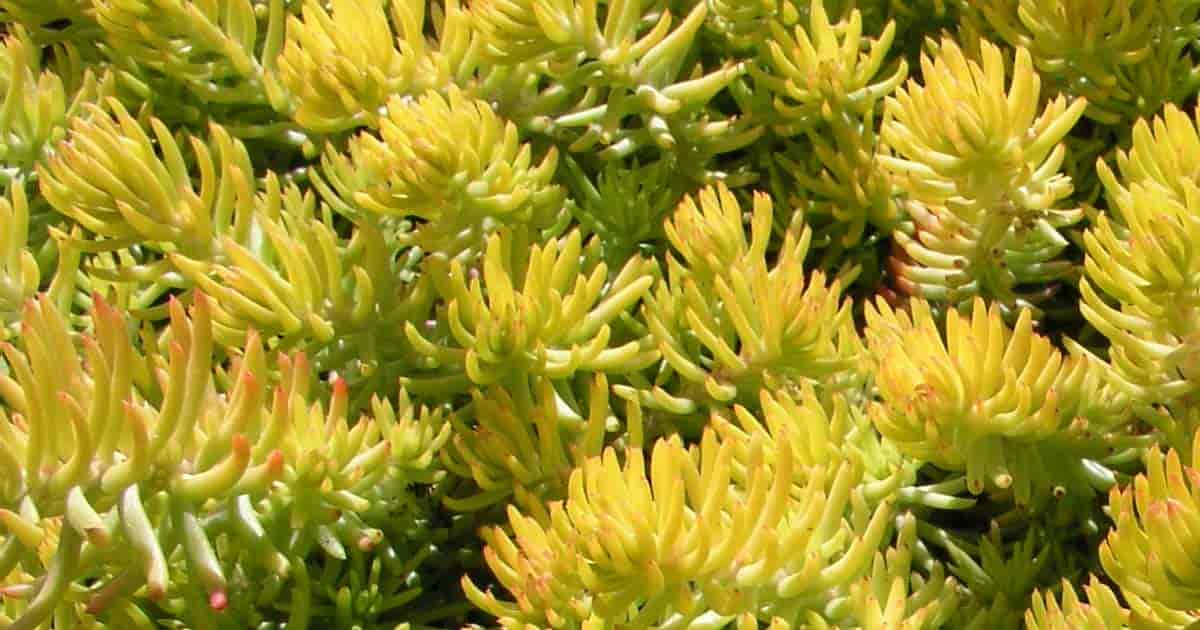Sedum reflexum (SEE-dum ree-FLEKS-um), also known as Sedum rupestre (rue-PES-tree), is a hardy evergreen perennial stonecrop (Sedum) species hailing from mountainous regions throughout North America and in some dry parts of South America.
The Sedum reflexum (Petrosedum rupestre) is a member of the Crassulaceae, a family in the genus Hylotelephium, otherwise known as stonecrops.

These plants are so-called because, in their native settings, they typically grow in stony, rocky areas.
The plant’s scientific name (Sedum) is Latin, derived from the word, sedeo. This refers to the plant’s growth habit of sitting and sprawling over stones.
Reflexum means “bent backward.” The alternate, rupestre, is a reference to rocks.
Common names include:
- Blue Spruce sedum
- Blue Spruce Stonecrop
- Crooked Yellow Stonecrop
- Stone Orpine
- Prickmadam
- Jenny’s Stonecrop
Taking care of the blue stonecrop is relatively easy. This includes providing proper blue spruce sedum care to ensure healthy growth.
Blue Spruce Sedum Reflexum Care
Size and Growth
The Jenny stonecrop is a mat-forming succulent with a blue-gray foliage color that can quickly reach a mature height of 6″ or 8″ inches. Individual plants may spread as wide as 2′ feet.
The plant spreads rapidly, forming a dense mat of bluish-green needle-like leaves arranged on their lax stems much like spruce needles.
Flowering and Fragrance
The star-shaped yellow flowers of blue spruce succulent are small individually, but they grow in attractive yellow clusters beginning in early summer and continuing all summer.
The lightly fragrant star-shaped flowers are quite attractive to butterflies.

Light Requirements and Temperature Needs
Blue Spruce Sedum is easy to grow in full sun settings with well-drained soil and little water. It can tolerate some shade, but it greatly prefers heat and sun.
The blue spruce succulent is winter hardy in USDA hardiness zone 3 through 9.
The Blue spruce sedum in winter can withstand freezing temperatures as low as -30°F (-34°C).
During this season, the plant may become dormant or semi-dormant, meaning it will grow at a slower rate but can still survive.[4]
Watering and Feeding
Blue Spruce Stonecrop is a drought-resistant plant that requires very little water. Water deeply from below or at ground level only when the soil is dry, especially during the growing season.

Fertilizing is unnecessary, but you can sprinkle a bit of granular fertilizer on the soil’s surface in the springtime if you wish.
Soil and Transplanting
Any soil pH level is acceptable, and the Sedum reflexum ‘blue spruce’ likes to be in well-draining ordinary or sandy soil.
The stonecrop blue spruce does best in very gravelly, unfertile soil. Rich soil produces floppy, weak growth.

Grooming and Maintenance
Reflexum sedum is a low maintenance plant. To encourage more dense growth habits and more blooming, mow blue spruce ground cover plantings early in the spring.
When kept in pots or containers, pinch or trim Bruce spruce succulent to encourage bushier growth and more blooms. Use cuttings to propagate new plants.
How To Propagate Blue Spruce Sedum Reflexum
Jenny’s stonecrop propagation is easy. Break off healthy stems in early or late summer and poke them into the soil. They will take root readily and grow in a quick and carefree manner.

You can also propagate the plant through almost any other means of propagation, such as root ball division, simple layering, or sowing seed indoors or outdoors after all danger of frost has passed.
Other Popular Sedum Plants
- Donkey Tail Plant (Sedum morganianum)
- Sedum Acre Gold Moss
- Pink Sedum sieboldii
- Jelly Bean Succulent (Sedum rubrotinctum)
Sedum Rupestre Blue Spruce Pest or Diseases
This rugged Sedum reflexum has few, if any, disease or insect problems. Just maintain a sparse watering schedule and plant reflexum in a full sun setting with sharply draining soil, and you should experience no problems at all.
In a damp setting, slugs, snails, and bacterial and fungal infections may be problematic.
In settings where the Sedum blue spruce plant is overcrowded or overwatered, scale insects, mealybugs, and aphids may be present.
To deal with these problems, see our article on Controlling Succulent Pests.

Is Reflexum Considered Toxic or Poisonous To People, Kids, Pets?
Sedum reflexum is an edible plant and is sometimes used as an herb or added to fresh salads.
Is The Jenny’s Stonecrop Considered Invasive?
Although this plant is not listed as invasive, it is wise to keep an eye on it and control its growth and spread.

Blue spruce ground cover is hardy, adapts well, and grows rapidly. It’s a good idea not to mix it in with slower growing stonecrops because it can quickly overtake them and smother them.
Suggested Sedum Reflexum Blue Spruce Uses
Grow Sedum Blue Spruce in containers and tubs or open areas where you seek a tolerant groundcover.
The plant is also good for edging and naturalizing, but you must stay on top to prevent it from running rampant.
The Blue spruce stone crop has naturalized in Washington state, many eastern states, and a good portion of Canada.

It is an especially beautiful addition to rock gardens, alpine gardens, mass plantings, container planting, and green roofs. The blue spruce stonecrop plant is also a good choice to naturalize in areas with very dry soil, clay soil, or problems with erosion.
The plant is rabbit and deer resistant, drought tolerant, and in some very hot, sunny, full sun locations, it can even be used as a lawn substitute.
Moreover, Blue spruce sedum is known for attracting bees, butterflies, and other pollinators due to its clusters of bright yellow that create a smashing floral display in summer.